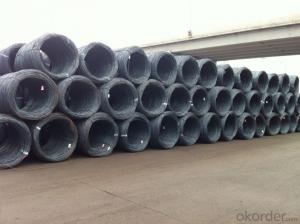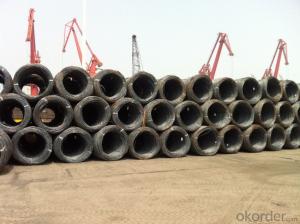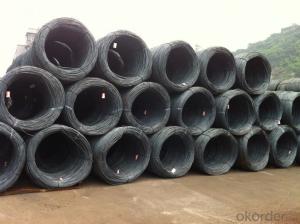Hot Rolled Wire Rods Best Quality and Price
- Loading Port:
- Tianjin
- Payment Terms:
- TT OR LC
- Min Order Qty:
- 25 m.t.
- Supply Capability:
- 20000 m.t./month
OKorder Service Pledge
OKorder Financial Service
You Might Also Like
Item specifice
Grade: SAE1008 Standard: ASTM
Diameter: 5.5mm, 6.5mm, 7mm, 8mm, 9mm, 10mm, 11mm, 12mm
Alloy or Not: Alloy
Technique: Hot Rolled Place of Origin: China Mainland
Chemical Composition:
Please kindly find our chemistry of our material based on SAE1008 as below for your reference:
Grade | Chemical Composition (%) | |||||
C | Mn | S | P | Si | B | |
SAE1008 | 0.10max | 0.30-0.50 | 0.050max | 0.040max | 0.30max | 0.0008min |
Mechanical properties | ||||||
Yield strength(N/mm2) | Tensile strength(N/mm2) | Elongation (%) | ||||
≥195 | 350-380 | ≥32 | ||||
Usage and Applications of Wire Rod:
After hot-rolled the products shaped into coil and delivery as finished product, including round, square,rectangular, hexagonal and so on. Since most of the products are round, it is generally called wire rod. Carbon steel wire rod is widely used in construction and manufacturing. Carbon steel wire rod is mainly used for reinforcement of reinforced concrete and welded structure or reprocessed (roberts , nail, etc.) materials, especially used to produce wire drawing, welding electrode, nails, spring, electronic, precise machinery parts and so on.
Packaging & Delivery of Wire Rod:
Packaging Detail: products are packed in coil and then shipped by container or bulk vessel
Each coil weight: About 2.05MT
Delivery Detail: within 45 days after received deposit or LC.
Label: to be specified by customer, generally, each bundle has 1-2 labels
Trade terms: FOB, CFR, CIF
FAQ:
Q1: How soon can we receive the product after purchasement?
A1: Within three days of placing an order, we will begin production. The specific shipping date is dependent upon international and government factors, but is typically one month.
Q2: How do you guarantee the quality of our products?
A2: We have established an advanced quality management system which conducts strict quality tests at every step, from raw materials to the final product. At the same time, we provide extensive follow-up service assurances as required.
Q3:What's your payment terms ?
A3:Mostly,we collect the money by T/T and LC at sight . We also accept time LC at 90/120 days sight.
Images of Wire Rod
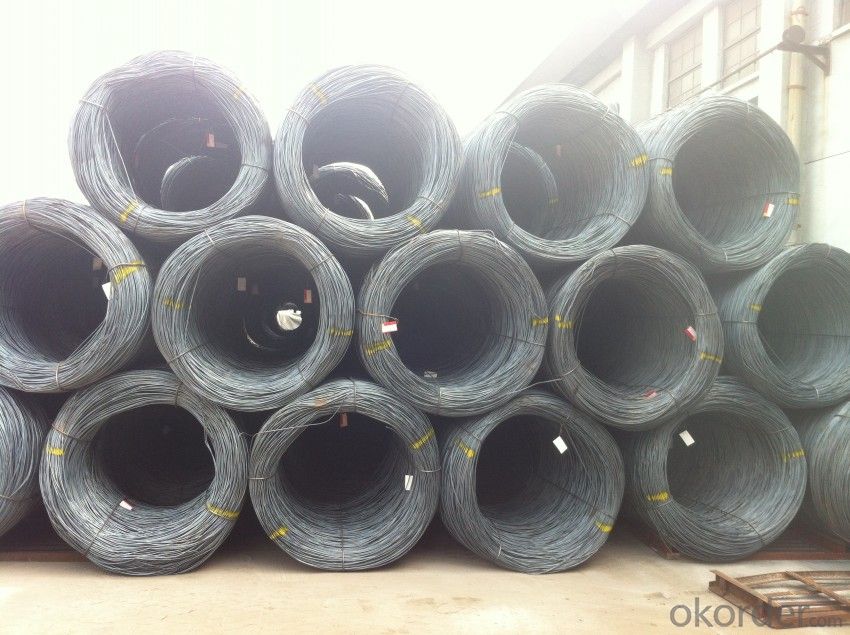
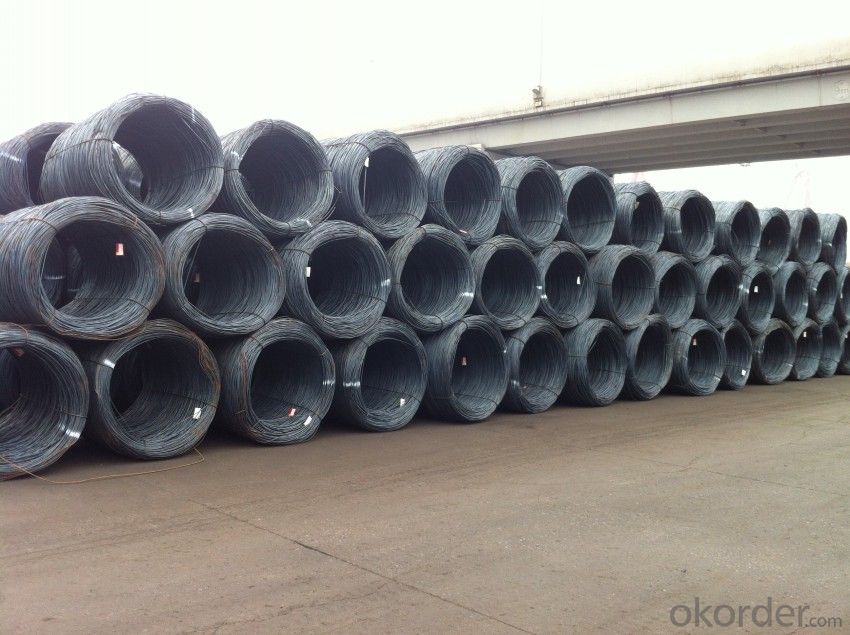
- Q:How is steel wire rod bundled and packaged for transportation?
- Steel wire rods are bundled and packaged for transportation to ensure their safety and ease of handling. There are several methods commonly used for bundling and packaging steel wire rods. One common method is to bundle the rods together using steel straps or wires. The rods are typically arranged in a neat stack, and the straps or wires are tightly wrapped around the bundle to hold the rods securely in place. This bundling method helps to prevent the rods from shifting or rolling during transportation, reducing the risk of damage. In addition to bundling, steel wire rods are often packaged in wooden crates or pallets for added protection. These crates or pallets provide a sturdy and stable base for the bundled rods, making it easier to lift and move them using forklifts or other handling equipment. The crates or pallets also shield the rods from direct contact with the ground, minimizing the risk of corrosion or other damage. To further protect steel wire rods during transportation, they may be wrapped in plastic or shrink-wrap. This additional layer of packaging helps to shield the rods from moisture, dust, and other contaminants that could potentially cause corrosion or surface damage. Labels and markings are also applied to the bundles and packaging to provide important information about the contents, such as the type and grade of steel, the quantity of rods, and any specific handling instructions. These labels and markings assist in the efficient and accurate identification and handling of the steel wire rods during transportation and storage. Overall, bundling and packaging steel wire rods for transportation involves securing the rods together using steel straps or wires, placing them in wooden crates or pallets, and adding additional protection through plastic or shrink-wrap. This ensures that the rods are well-protected, organized, and easily handled throughout the transportation process.
- Q:How does the fatigue strength of steel wire rod vary with different diameters?
- Steel wire rod fatigue strength typically varies depending on its diameter. Generally, an increase in diameter leads to a decrease in fatigue strength. This occurs because larger diameter rods have a greater likelihood of containing defects or imperfections, such as inclusions or microstructural irregularities. These flaws act as stress concentrators, reducing the fatigue strength. Furthermore, larger diameter rods have a larger surface area, increasing the chances of surface defects or corrosion. These factors can negatively impact the fatigue strength. Additionally, larger diameter rods have lower bending stiffness, resulting in higher stresses and strains under cyclic loading, further reducing fatigue strength. Conversely, smaller diameter steel wire rods tend to have higher fatigue strength due to their reduced surface area and fewer chances of defects. Smaller diameter rods also have higher bending stiffness, which helps distribute the applied load more evenly, reducing localized stress concentrations and improving fatigue strength. However, it is important to note that other factors can influence the fatigue strength of steel wire rods, such as the specific type and quality of the steel, the manufacturing process, and the surface treatment. Therefore, when evaluating fatigue strength, it is necessary to consider these factors in addition to the diameter.
- Q:What are the common production processes for vanadium-coated steel wire rod?
- The common production processes for vanadium-coated steel wire rod include heating the steel rod to a specific temperature, applying a vanadium coating through either electroplating or hot-dip galvanizing methods, and then cooling and finishing the wire rod to the desired specifications.
- Q:How is steel wire rod used in the production of wire mesh reinforcement?
- Wire mesh reinforcement relies on steel wire rod, an indispensable element in its production. This raw material is fundamental for manufacturing wire mesh, extensively employed in construction and other sectors to reinforce concrete structures. The process of producing wire mesh reinforcement commences with the treatment of steel wire rod. Typically, the rod undergoes a series of manufacturing steps, wherein it is drawn through dies to decrease its diameter and increase its length. This wire drawing procedure yields a longer and thinner wire with enhanced mechanical properties. Subsequently, the drawn wire is fed into a specialized apparatus known as a wire mesh welding machine. This machine utilizes electric resistance welding to connect the wires, forming a grid-like pattern. The welding process guarantees secure bonding at the intersections, resulting in a robust and long-lasting wire mesh. The application of wire mesh reinforcement spans across various construction projects, including the creation of concrete slabs, walls, and columns. It is embedded within concrete structures to augment strength, prevent cracking, and enhance the overall load-bearing capacity. By acting as reinforcement, the wire mesh evenly distributes forces and stresses throughout the concrete, thereby bolstering its structural integrity. Moreover, wire mesh reinforcement finds utility in diverse industries such as agriculture, mining, and manufacturing. In agriculture, it is commonly employed as fencing to safeguard livestock and crops. In mining, wire mesh serves safety purposes, preventing rockfalls and supporting tunnel walls. In manufacturing, wire mesh is utilized for filtration, separation, containment, and other applications. To summarize, steel wire rod assumes a critical role in wire mesh reinforcement production. Its transformation through wire drawing and subsequent welding forms the foundation for the creation of durable and versatile wire mesh. This reinforcement is widely utilized in construction and other industries to enhance the strength and integrity of various structures.
- Q:How is the surface cleanliness of steel wire rod tested?
- The surface cleanliness of steel wire rod is typically tested using various methods to ensure its quality and suitability for further processing or use. One commonly used technique is visual inspection, where the wire rod is visually examined for any visible contaminants or defects on its surface. Another method involves using a microscope or magnifying glass to closely examine the surface of the wire rod. This allows for a more detailed inspection, enabling the detection of smaller particles or defects that may not be visible to the naked eye. In addition to visual inspection, other techniques such as magnetic particle inspection (MPI) or dye penetrant inspection (DPI) may be employed. MPI involves applying a magnetic field to the wire rod and then applying a magnetic particle solution, which will reveal any surface defects or cracks. DPI, on the other hand, involves applying a colored dye to the surface of the wire rod, which will seep into any cracks or defects, making them more visible. Furthermore, surface cleanliness can also be measured using non-destructive testing techniques such as ultrasonic testing or eddy current testing. Ultrasonic testing involves sending high-frequency sound waves through the wire rod, and any irregularities or contaminants on the surface will reflect these waves differently, allowing for their detection. Eddy current testing, on the other hand, uses electromagnetic induction to identify surface defects or contaminants by detecting changes in the electrical conductivity of the wire rod. Overall, the surface cleanliness of steel wire rod is tested using a combination of visual inspection, microscopic examination, and various non-destructive testing techniques to ensure its quality and suitability for different applications. These methods help identify any surface defects, contaminants, or irregularities that may affect the performance or integrity of the wire rod.
- Q:What are the main factors influencing the choice of steel wire rod order product testing options?
- The main factors influencing the choice of steel wire rod order product testing options include quality control requirements, customer specifications, industry standards, and regulatory compliance. Firstly, quality control requirements play a crucial role in determining the testing options for steel wire rod orders. Manufacturers and suppliers often have their own quality control measures in place to ensure that the products meet the required standards. These measures may include various types of testing such as chemical composition analysis, mechanical property testing, and dimensional inspections. The choice of testing options depends on the specific quality control requirements set by the manufacturer or customer. Customer specifications also heavily influence the testing options for steel wire rod orders. Different customers may have specific requirements or preferences when it comes to the quality and performance of the product. For instance, customers in the automotive industry may have stringent specifications regarding the tensile strength or ductility of the wire rod. In such cases, specialized testing methods may be required to meet these specifications. Industry standards are another important factor in determining the testing options for steel wire rod orders. Various industry organizations and associations set standards and guidelines for the production and testing of steel wire rods. These standards ensure that the products meet the minimum requirements for safety, performance, and reliability. Testing options are chosen based on the specific industry standards that need to be met. Additionally, regulatory compliance is a significant factor influencing the choice of testing options. Steel wire rod manufacturers and suppliers must adhere to the regulations and requirements set by governmental bodies or agencies. These regulations may include specific testing protocols to ensure the safety and quality of the products. Testing options are selected accordingly to meet these regulatory compliance requirements. In summary, the main factors influencing the choice of steel wire rod order product testing options are quality control requirements, customer specifications, industry standards, and regulatory compliance. These factors ensure that the products meet the necessary quality, performance, and safety standards set by manufacturers, customers, and regulatory bodies.
- Q:How is steel wire rod manufactured in an electric arc furnace?
- Steel wire rod is manufactured using an electric arc furnace (EAF) through a series of steps. The process begins with the raw materials, which typically include iron ore, scrap metal, and carbon additives. These materials are carefully selected to ensure the desired chemical composition and quality of the steel wire rod. Firstly, the raw materials are charged into the electric arc furnace. The furnace is a large, refractory-lined vessel capable of withstanding extremely high temperatures. Once the furnace is charged, an electric current is passed through graphite electrodes that are positioned above the scrap metal and raw materials. As the electric current passes through the electrodes, it creates an electric arc that generates intense heat. This heat melts the raw materials and scrap metal, resulting in a molten pool of liquid steel. The temperature in the furnace can reach up to 3,000 degrees Celsius. Once the steel is melted, various refining processes are employed to remove impurities and adjust the chemical composition. Oxygen and other gases are injected into the furnace to remove carbon and other elements that need to be reduced. Alloying elements such as manganese, chromium, and nickel may also be added at this stage to achieve the desired properties of the final product. After the refining process, the molten steel is tapped from the furnace into a ladle, where it is further treated to remove any remaining impurities. The ladle is then transported to a continuous casting machine, where the molten steel is solidified into billets or blooms. The solidified billets or blooms are then transferred to a rolling mill, where they are heated and rolled into wire rod. The rolling process involves passing the billets or blooms through a series of rollers that gradually reduce their cross-sectional area, resulting in the desired wire rod dimensions. The wire rod is then cooled and coiled into large coils. Finally, the coiled wire rod is subjected to various finishing processes, such as surface cleaning, heat treatment, and surface coating, to enhance its quality and appearance. The finished wire rod is then ready for further processing, such as drawing, cold heading, or other applications in the steel industry.
- Q:What are the different types of steel wire rod surface coatings?
- There are several types of steel wire rod surface coatings, including zinc coatings, galvanized coatings, copper coatings, and various types of organic coatings.
- Q:What are the main factors affecting the corrosion resistance of steel wire rod?
- The main factors affecting the corrosion resistance of steel wire rod include the composition of the steel, the presence of impurities or alloying elements, the surface condition and finish of the wire rod, the environmental conditions such as humidity and temperature, and the presence of corrosive agents like moisture, chemicals, or salts.
- Q:What are the main factors affecting the formability of steel wire rod?
- The main factors affecting the formability of steel wire rod include the composition of the steel, its microstructure, mechanical properties such as yield strength and ductility, as well as the processing conditions such as temperature, strain rate, and lubrication.
1. Manufacturer Overview |
|
|---|---|
| Location | |
| Year Established | |
| Annual Output Value | |
| Main Markets | |
| Company Certifications | |
2. Manufacturer Certificates |
|
|---|---|
| a) Certification Name | |
| Range | |
| Reference | |
| Validity Period | |
3. Manufacturer Capability |
|
|---|---|
| a)Trade Capacity | |
| Nearest Port | |
| Export Percentage | |
| No.of Employees in Trade Department | |
| Language Spoken: | |
| b)Factory Information | |
| Factory Size: | |
| No. of Production Lines | |
| Contract Manufacturing | |
| Product Price Range | |
Send your message to us
Hot Rolled Wire Rods Best Quality and Price
- Loading Port:
- Tianjin
- Payment Terms:
- TT OR LC
- Min Order Qty:
- 25 m.t.
- Supply Capability:
- 20000 m.t./month
OKorder Service Pledge
OKorder Financial Service
Similar products
New products
Hot products
Related keywords
